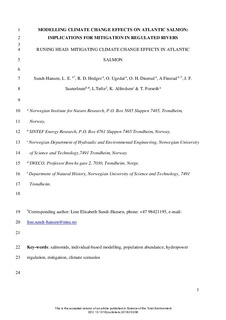| dc.contributor.author | Sundt-Hansen, Line Elisabeth Breivik | |
| dc.contributor.author | Hedger, Richard David | |
| dc.contributor.author | Ugedal, Ola | |
| dc.contributor.author | Diserud, Ola Håvard | |
| dc.contributor.author | Finstad, Anders Gravbrøt | |
| dc.contributor.author | Sauterleute, Julian Friedrich | |
| dc.contributor.author | Tøfte, Lena S | |
| dc.contributor.author | Alfredsen, Knut | |
| dc.contributor.author | Forseth, Torbjørn | |
| dc.date.accessioned | 2019-01-29T13:37:31Z | |
| dc.date.available | 2019-01-29T13:37:31Z | |
| dc.date.created | 2018-03-17T13:11:29Z | |
| dc.date.issued | 2018 | |
| dc.identifier.citation | Science of the Total Environment. 2018, 631-632 1005-1017. | nb_NO |
| dc.identifier.issn | 0048-9697 | |
| dc.identifier.uri | http://hdl.handle.net/11250/2582866 | |
| dc.description.abstract | Climate change is expected to alter future temperature and discharge regimes of rivers. These regimes have a strong influence on the life history of most aquatic river species, and are key variables controlling the growth and survival of Atlantic salmon. This study explores how the future abundance of Atlantic salmon may be influenced by climate-induced changes in water temperature and discharge in a regulated river, and investigates how negative impacts in the future can be mitigated by applying different regulated discharge regimes during critical periods for salmon survival. A spatially explicit individual-based model was used to predict juvenile Atlantic salmon population abundance in a regulated river under a range of future water temperature and discharge scenarios (derived from climate data predicted by the Hadley Centre's Global Climate Model (GCM) HadAm3H and the Max Plank Institute's GCM ECHAM4), which were then compared with populations predicted under control scenarios representing past conditions. Parr abundance decreased in all future scenarios compared to the control scenarios due to reduced wetted areas (with the effect depending on climate scenario, GCM, and GCM spatial domain). To examine the potential for mitigation of climate change-induced reductions in wetted area, simulations were run with specific minimum discharge regimes. An increase in abundance of both parr and smolt occurred with an increase in the limit of minimum permitted discharge for three of the four GCM/GCM spatial domains examined. This study shows that, in regulated rivers with upstream storage capacity, negative effects of climate change on Atlantic salmon populations can potentially be mitigated by release of water from reservoirs during critical periods for juvenile salmon. | nb_NO |
| dc.description.abstract | Modelling climate change effects on Atlantic salmon: Implications for mitigation in regulated rivers | nb_NO |
| dc.language.iso | eng | nb_NO |
| dc.publisher | Elsevier | nb_NO |
| dc.relation.uri | http://hdl.handle.net/11250/2580300 | |
| dc.rights | Attribution-NonCommercial-NoDerivatives 4.0 Internasjonal | * |
| dc.rights.uri | http://creativecommons.org/licenses/by-nc-nd/4.0/deed.no | * |
| dc.title | Modelling climate change effects on Atlantic salmon: Implications for mitigation in regulated rivers | nb_NO |
| dc.type | Journal article | nb_NO |
| dc.type | Peer reviewed | nb_NO |
| dc.description.version | acceptedVersion | nb_NO |
| dc.source.pagenumber | 1005-1017 | nb_NO |
| dc.source.volume | 631-632 | nb_NO |
| dc.source.journal | Science of the Total Environment | nb_NO |
| dc.identifier.doi | 10.1016/j.scitotenv.2018.03.058 | |
| dc.identifier.cristin | 1573660 | |
| dc.relation.project | Norges forskningsråd: 177893 | nb_NO |
| cristin.unitcode | 7548,50,0,0 | |
| cristin.unitname | Energisystemer | |
| cristin.ispublished | true | |
| cristin.fulltext | postprint | |
| cristin.qualitycode | 2 | |

